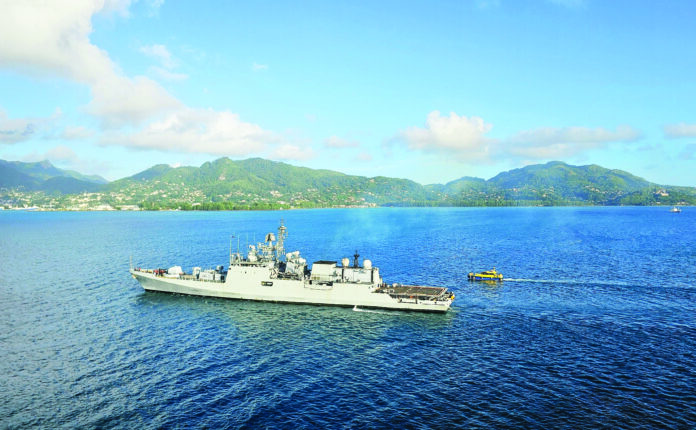
India’s naval force isn’t about seeking conflict; it’s about preventing it.
NEW DELHI: In the choppy currents of Indo-Pacific geopolitics, India’s naval strategy has often been painted as ambiguous or reactionary. Critics question whether the country has a coherent maritime vision or if it simply shifts course in response to external provocations. These doubts, however, do not hold up under scrutiny. A close reading of India’s maritime doctrine reveals a deliberate, transparent, and evolving strategy grounded in national interests, regional stability, and international law.
At the heart of this clarity is the Indian Maritime Doctrine (IMD), the official articulation of naval objectives and operational vision. Far from vague posturing, the doctrine lays out India’s naval posture in no uncertain terms. It sets the tone for maritime security, power projection, and regional partnerships, ensuring that India’s intentions are not just known but well understood.
DETERRENCE, NOT AGGRESSION
The IMD emphasises deterrence as a core pillar, not aggression. India’s naval force isn’t about seeking conflict; it’s about preventing it. Deterrence, in this context, means maintaining credible combat capabilities to dissuade adversaries from testing India’s resolve. This message is repeated clearly and consistently: the Indian Navy’s objective is to avoid war through strength and readiness, not to provoke it.
This principle helps push back on the idea that India is growing its naval presence in a vacuum. With rising tensions in the South China Sea and assertive posturing from other major powers, India’s maritime build-up is not an escalation. It’s insurance.
SEA CONTROL VS SEA DENIAL
India’s doctrine makes a critical distinction between sea control and sea denial—concepts often blurred by casual observers. Sea control is about ensuring freedom of navigation in key areas, vital for trade and defence logistics. Sea denial, on the other hand, involves denying adversaries the same freedom in times of conflict.
The IMD acknowledges India’s need to maintain sea control in its primary area of interest, which stretches from the Persian Gulf to the Strait of Malacca. These waters are not just lines on a map; they are arteries of energy, commerce, and national security. India’s maritime doctrine makes it clear that it is not seeking global domination but aiming to ensure that these lifelines remain open and secure for everyone.
INDIGENISATION AS THE BUZZWORD
Another key term in India’s naval playbook is indigenisation. This refers to the domestic development of naval platforms, technologies, and logistics. Why does this matter strategically? Because it emphasises India’s commitment to self-reliance, not external adventurism. The emphasis on “Make in India” for defence production is not a signal of autarky or disengagement. It’s about sustainable security architecture.
The doctrine ties indigenisation directly to strategic autonomy. When India builds its own warships and submarines, it reduces its dependency on external suppliers during crises, thereby enhancing operational freedom without needing to engage in sabre-rattling.
PARTNERSHIPS FOR NAVAL DIPLOMACY
India’s doctrine does not view maritime strength as a solo act. It stresses the value of maritime partnerships and interoperability with friendly navies. This includes structured exercises like Malabar with Quad navies, joint patrols with the Association of Southeast Asian Nations (ASEAN) nations, and coordinated anti-piracy operations in the Gulf of Aden. These are not just Public Relations stunts. They are doctrinal commitments to cooperative security.
This multilateralism dismantles the argument that India is unpredictable at sea. On the contrary, it signals predictability and accountability. India isn’t moving unilaterally. It’s operating alongside allies who share an interest in a rules-based maritime order.
NON-TRADITIONAL THREATS AND HADR ROLES
India’s maritime doctrine also acknowledges non-traditional threats like piracy, illegal fishing, maritime terrorism, and climate-induced disasters. By clearly including Humanitarian Assistance and Disaster Relief (HADR) operations in its core mission, India shows that its navy is not only a tool of hard power but also a stabilising presence in the region.
For example, the Indian Navy’s rapid response after the 2004 tsunami, as well as its more recent efforts during pandemic logistics and natural calamities across the Indian Ocean, has cemented its role as a first responder, not just a combat force.
TRANSPARENCY AND ITERATIONS
Perhaps the most important word that undercuts claims of strategic ambiguity is transparency. India has not only published its maritime doctrines but also regularly updated them. From the original IMD of 2004 to its 2009 and 2015 iterations, the document reflects changing strategic realities and adjusts priorities accordingly. These updates are publicly available and openly discussed, unlike the often opaque strategies of other regional powers.
This transparency reflects a commitment to accountable maritime policy—a quality far from reckless or unclear. Critics often overlook this simple fact: India tells the world what it’s doing and why.
BLUEPRINT FOR NATIONAL STRATEGY
India’s maritime doctrine is not an improvised response to regional anxiety. It’s a well-documented, clearly worded blueprint of national strategy at sea. With concepts such as deterrence, sea control, indigenisation, partnerships, and transparency explicitly articulated, India has clearly and consistently shown its cards.
Strategic clarity does not require loud declarations or confrontational moves. It requires a steady compass, open intentions, and coherent doctrine. India has all three. And that, more than any knee-jerk critique, is the real measure of its maritime maturity.
* Ashish Singh is an award-winning senior journalist with over 18 years of experience in defence and strategic affairs.







